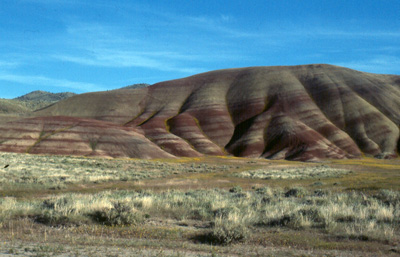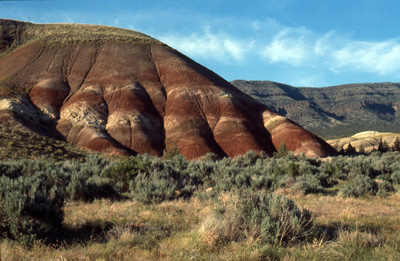THE GREAT PLACENTA
"We belong to a mystery that will never belong to us," says poet John Daniel, "yet it is freely given to all who desire it. Though we distance ourselves, and fail to see, it is granted everywhere and all the time. It does not fail us [although we may fail it]." Soil is a part of the vast mystery to which we belong. "To forget how to dig the earth and tend the soil is to forget ourselves," wrote Mahatma Gandhi.1
Many cultures have emphasized the trusteeship of the soil through religion and philosophy. The biblical Abraham, in his covenant with God, was instructed: "Defile not therefore the land which ye shall inhabit, wherein I dwell."2 The Chinese philosopher Confucius saw in the Earth's thin mantle the sustenance of all life and the minerals treasured by human society. A century later in Greece, Aristotle thought of soil as the central mixing pot of air, fire, and water that formed all things.
by
Chris Maser


In spite of the durability of such beliefs, most people cannot grasp their profundity because the ideas are intangible, on the one hand, and because, on the other, the march toward technological specialization increasingly isolates us—the modern human—from nature and our place in it, even in Antarctica.
The ecosystems of Antarctica are often considered to be nearly pristine because the levels of human disturbance are extremely low. Nevertheless, a rapid increase in the number of people, researchers and tourists, visiting Antarctica over recent decades has begun to alter that perspective. A decadal study of the direct impact of foot traffic on the abundance of soil animals and soil properties was conducted in Taylor Valley within the McMurdo Dry Valleys region of this southernmost continent. During the study, soils from minimally disturbed areas were compared with those from nearby paths, which received intermediate and high levels of human foot traffic, that is to say somewhere in the neighborhood of 80 passes annually. The results clearly show that even low levels of human traffic can have significant negative affects on soil biota in this ecosystem and thereby may alter ecosystem processes, such as carbon cycling. In fact, one site showed evidence those high levels of trampling reduced the fluxes of carbon dioxide in the soil, which is related to total biological activity in the soil.3
This apparent invisibility of the soil stems from the fact that it's as common as air and, like air, is a birthright belonging to everyone and so to no one, and thus it is taken for granted. For example, the Federal Bureau of Soils stated in 1909 that, "the soil is the one indestructible, immutable asset that the nation possesses. It is the one resource that cannot be exhausted."4
"Soil is the most diverse and important ecosystem on the planet. Myriad biophysical and biochemical processes persist in parallel that are required to sustain all of the other trophic levels in the biosphere," according to soil scientists I. M. Young and J. W. Crawford of the University of Abertay in Scotland.5 Although to many people soil seems "invisible" and thus indestructible, it's a seamless whole—the complexity of which seems all but unknown and beyond comprehension, even to soil scientists.
Whether most people understand it or not, soil is important for at least seven reasons:
-
Soil is the stage on which human life and its many constructs are physically supported. "In many ways, the ground beneath our feet is as alien as a distant planet. The processes occurring in the top few centimeters [inches] of Earth's surface are the basis of all life on dry land, but the opacity of soil has severely limited our understanding of how it functions. As creatures of the aerial world we have a decidedly distorted view of this nurturing underworld."6
-
Soil shelters seeds and provides physical support for their roots as they germinate, grow, and mature into adult plants that seed and thus perpetuate the cycle.
-
Soil stores elements that, in the proper proportions and availability, can act as nutrients for the plants growing in it—and through the plants for us.
-
Soil plays a central role in the decomposition of dead organic matter, and in so doing not only renders harmless many potential pathogens, including those of humans, but also adds to its own store of potential nutrients.
-
Soil is the nursery for spores of the microbes, as well as for decomposer and mycorrhizal fungi, the latter of which nourish the myriad plants.
-
Soils of various kinds, acting in concert, are a critical factor in regulating the major elemental cycles of the Earth—those of carbon, nitrogen, sulfur, and so on.
- Soil both stores and purifies water.7
If you think about the social-environmental value of soil, it is not surprising that some of the earliest written documents detailing the care and knowledge of soil were agricultural manuals.8 This recognition has resulted in profound statements: "The social lesson of soil waste is that no man has the right to destroy soil even if he does own it in fee simple. The soil requires a duty of man, which we have been slow to recognize" (Henry A. Wallace, 1938).9 "In the old Roman Empire, all roads led to Rome. In agriculture all roads lead back to the soil from which farmers make their livelihood" (G. Hambrige, 1938).10
Although both of these statements are as true now as the day they were uttered, it is the doom of people that they too soon forget. Having said this, however, I must acknowledge that few people know what soil really is. Soil, the very foundation of life, is a long time in the making, as will be discussed in the following sections. Sacred as soil is, it nevertheless is all too quickly profaned and depleted.
Soil, the properties of which vary from place to place within a landscape, is by far the most alive and biologically diverse part of a terrestrial ecosystem. In addition, soil microorganisms are the regulators of most processes that translate into soil productivity. "Each soil," says author Hans Jenny, "is an individual body of nature, possessing its own character, life history, and powers to support plants and animals."11
Looking at the clod of soil, I see tiny sparkles as a few of the larger, individual particles reflect the sun's brilliance off their facets. And it occurs to me that poet Robert Blake's insight is correct—each grain of sand, each particle of soil does indeed reflect the universe, not only by tossing back a glint of the sun by day and the soft light of the moon by night but also by its long history through the atomic interchange.
The atomic interchange of soil is the result of two opposing geological forces—the fiery volcanism that builds mountains and the erosive powers that work to level them. As a volcano is built by fire from within, so it is eroded by wind, water, and ice from without. It defies gravity in its growing and falls to gravity in its dying. As with all mountains, volcanoes are "born," "die," and return, in concert with the creative novelty of all "living" things on Planet Earth, to the Great Mystery from which they came.

Beyond that, the processes through which soil develops are divided into two categories of weathering, physical and chemical, both of which depend on: (1) properties of the "parent" rock, such as its physical and chemical composition; (2) patterns of regional and local climate; and (3) the kinds of plants and animals that are available and capable of becoming established in the newly forming soil.
ENDNOTES


©Chris Maser 2009. All rights reserved. The closing photograph (the one prior to "Endnotes") is by and courtesy of Sue Johnston>